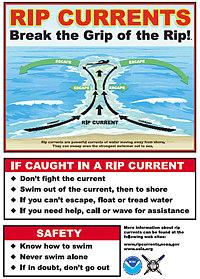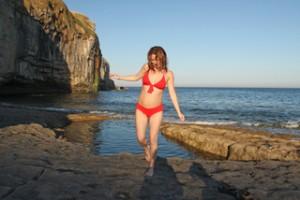
Escaping a rip is straightforward if you are a strong swimmer and remain calm. People drown from panic, followed by exhaustion, so never fight against the current. Keep an eye on a shore landmark to establish whether you are in a rip. If so, stand or wade if possible. If not, swim out of it at 90 degrees parallel to the beach for about 20m. Once out of the rip, head back towards the beach, using the waves to body-surf you back in. If you are too exhausted to swim, raise your arm to attract attention and lie on your back – or on a board of you have one – to conserve energy. Remember, rips only extend to the back of the surf, rarely more than 100m, often less. They also slow down as they get further from shore.
Rip currents are offshore surface currents that re-circulate water out to the back of the surf breaks during high surf. They increase in strength as the surf increases and do not occur in calm seas.Rips tend to form in natural channels: between sand bars; in a river mouth or estuary; or along a pier, jetty, groyne or rock stack. In coves, rips tend to form along the edges. Look for a calmer, possibly rippled, channel between the incoming surf breaks. Sometimes the channel is deep green in colour, or may be carrying foam or debris, or stirring up sediment. The waterline at the shore will also be a little lower where the rip begins. Surfers often use rips to take them out beyond the breaks, so ask them for advice. See US and Australiansurf lifesaving websites for more guidance.
Cross-shore rips occur when surf is coming in at an angle to the coast and creating a current across the beach. They will not take you out to sea, but may take you out of your depth.
‘Dumping’ surf forms on steeply shelving beaches (particularly on the shingle beaches of the south and east coasts, such as Chesil or Dungeness). This type of surf breaks quickly and heavily, dumping you hard on the ground. An immediate and highly localised undertow then sucks the water back out again, making it difficult to stand up and negotiate the steep shelf, especially if you are tired. Aim to land behind the breaking wave or try to find a more gently sloping part of the beach.
Tides are created by the moon. The sea floods as the tide comes in and levels rise. It ebbs as the tide goes out and levels drop. The power of the tide varies from day to day and affects the tidal range (height) and the flow rate (current). Tides are predictable but are highly variable and localised. Determinants of the tide’s strength include whether the water is slack, or in full flow (see rule of twelfths, left), and how close it is to a spring or neap tide.
 Spring and neap tides are respectively, strong and weak. At full or new moons the sun and moon are, astronomically speaking, in line. This creates the strongest gravitational pull on the sea and therefore strong tides, known as ‘spring’ tides occur, roughly every fortnight. At half-moons, sun and moon oppose each other, resulting in weak gravitational pull on the sea and creating weak tides, known as ‘neap’ tides. Spring tides might typically have a range of 5–6m, and 3–4 knots peak current. Neap tides are about a half to a third of that range. ‘Springs’ and ‘neaps’ always occur at the same time of day for a particular part of the coast. For Atlantic-facing coasts such as Cornwall, Devon and west Scotland, the peak spring high tides are always around 6am and 6pm – very handy for enjoying really low-tide beaches in the heat of the day!
Spring and neap tides are respectively, strong and weak. At full or new moons the sun and moon are, astronomically speaking, in line. This creates the strongest gravitational pull on the sea and therefore strong tides, known as ‘spring’ tides occur, roughly every fortnight. At half-moons, sun and moon oppose each other, resulting in weak gravitational pull on the sea and creating weak tides, known as ‘neap’ tides. Spring tides might typically have a range of 5–6m, and 3–4 knots peak current. Neap tides are about a half to a third of that range. ‘Springs’ and ‘neaps’ always occur at the same time of day for a particular part of the coast. For Atlantic-facing coasts such as Cornwall, Devon and west Scotland, the peak spring high tides are always around 6am and 6pm – very handy for enjoying really low-tide beaches in the heat of the day!
The direction of flow is of vital importance for swimmers. Britain’s south and west shores fill from the Atlantic up into the English Channel and Irish Sea, so tidal currents flow east in the flood and are progressively later as you go east to Dover or north to Liverpool. Britain’s east and north coasts fill from the North Sea, with waters moving south in the flood and becoming progressively later as you go south down the east coast. The east Dorset coast has very small tides where the two flows cancel each other out.
Coves and bays are protected from tidal flows (though of course the sea levels will still change) but open coast is exposed to tidal currents. Currents strengthen around restrictions, such as headlands or islands (Portland Bill or Ramsay Sound) or at estuary or harbour mouths (Chichester Harbour or Blackwater Estuary). Remember that at an estuary or river mouth the current will be carrying you inshore as the tide comes in (relatively safe) but offshore when the tide goes out (potentially very dangerous).
Rule of twelfths
If in doubt avoid the fastest flow in the middle hours of the tide. In the first hour of the tide, approximately one-twelfth of the water moves; in the second hour two-twelfths moves, during the third hour three-twelfths moves, and so on as the flow-rate decreases again.
What time is the tide? Tide cycles repeat every 12 hours, occurring half an hour later each time. They occur about an hour later each day.
Spring tides
Contrary to popular belief spring(strong) tides occur every fortnight at new and full moons and are only partly affected by the season.
Find tides for the whole country at the BBC tide website.
Trackbacks For This Post
10 reviews
[…] as well. If you’re on holiday, you’ve got the luxury of swimming in the sea. I don’t why, but swimming in the sea is just so relaxing. When you get home, you can go to a number of swimming pools in the area that […]
-What’s up everyone, it’s my first visit at this web page, and article is truly fruitful in favor of me, keep up posting such articles or reviews.
-You need to be a part of a contest for one of the highest quality websites online. I most certainly will recommend this site!
-Hi! I just wanted to ask if you ever have any trouble with hackers? My last blog (wordpress) was hacked and I ended up losing months of hard work due to no back up. Do you have any methods to stop hackers?
-This piece of writing will help the internet viewers for building up new web site or even a blog from start to end.
-Unquestionably believe that which you stated. Your favorite justification seemed to be on the web the easiest thing to be aware of. I say to you, I definitely get annoyed while people think about worries that they plainly don’t know about. You managed to hit the nail upon the top as well as defined out the whole thing without having side-effects , people can take a signal. Will likely be back to get more. Thanks
-After another month has passed, label and evaluate your spending to prepare you for the following month.
This kind of sideways movement could cause problems in the future for the cars performance.
How much time are you spending with your children, teaching them the ways
of life.-It’s a shame you don’t have a donate button! I’d without a doubt donate to this brilliant blog! I guess for now i’ll settle for book-marking and adding your RSS feed to my Google account. I look forward to new updates and will share this website with my Facebook group. Talk soon!
-Hey there! This is kind of off topic but I need some advice from an established blog. Is it hard to set up your own blog? I’m not very techincal but I can figure things out pretty quick. I’m thinking about making my own but I’m not sure where to start. Do you have any ideas or suggestions? Many thanks
-I would like to thank you for the efforts you’ve put in writing this website. I am hoping to see the same high-grade blog posts from you later on as well. In truth, your creative writing abilities has encouraged me to get my very own site now 😉
-WOW just what I was looking for. Came here by searching for n
-[…] lots of beach safetly and wild-swimming help & advice on the Wild Swimming blog. If you need any more help, tweet our NT Sport guru […]
-[…] Read more tips for wild swimming safety inland and for sea swimming safety […]
-Your Comments



















[…] as well. If you’re on holiday, you’ve got the luxury of swimming in the sea. I don’t why, but swimming in the sea is just so relaxing. When you get home, you can go to a number of swimming pools in the area that […]
[…] lots of beach safetly and wild-swimming help & advice on the Wild Swimming blog. If you need any more help, tweet our NT Sport guru […]
[…] Read more tips for wild swimming safety inland and for sea swimming safety […]